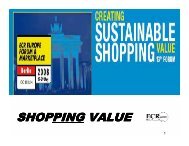Create successful ePaper yourself
Turn your PDF publications into a flip-book with our unique Google optimized e-Paper software.
10.2. Additional Data and Figures<br />
Dimensional proliferation of secondary unit loads<br />
To assess current dimensional proliferation project team<br />
members were asked to provide secondary unit load<br />
length, width and height for every SKU passing<br />
through their system. A selection of the results is given<br />
below. A proliferation of 25% means that on average<br />
four different articles (SKUs) are packaged in secondary<br />
unit loads having the same length, width and height<br />
(see Figure 41).<br />
European versus Industry pallet<br />
Figure 42 shows some of the advantages and<br />
disadvantages of using Industry versus Euro pallets in<br />
replenishment (transportation) and the RDC. The<br />
numbers, based on IGD (Institute of Grocery<br />
Distribution) DPP data, are averages, and are only<br />
indicative as they may differ significantly for different<br />
Figure 41: Proliferation of unit load dimensions<br />
70<br />
Manufacturer<br />
Retailer<br />
products (+ means more advantageous).<br />
In support of some of the percentages in Figure 42:<br />
• Figure 43 shows the impact on travel distance<br />
between picking faces when 1000 mm and 800<br />
mm are respectively presented to the aisle by<br />
Industry and Euro pallets. One figure shows<br />
the theoretical impact and the second that<br />
applicable in a warehouse with racking<br />
columns (These diagrams serve as a thought<br />
provoker – they are examples which may or<br />
may not apply to particular layouts).<br />
• Figure 44 shows that Industry pallets, because<br />
they carry 25% more than Euro pallets, can<br />
have a significant impact on overall stock<br />
levels<br />
• Figure 44 also shows how handling efficiency<br />
can favour either the Industry pallet or the<br />
Euro pallet depending on the handling<br />
method used.<br />
A 1 B 1 C 1 D 2 F 3 G 4 H 4 Average<br />
Active SKUs 143 350 3,622 2,077 174 26 21 1,069<br />
Different lengths 26 4 314 129 19 2 11 84<br />
Different widths 28 4 264 129 25 3 11 77<br />
Different heights 26 48 353 136 57 3 11 106<br />
Different plan dimensions 33 4 738 329 54 3 11 195<br />
Different load dimensions 37 96 958 420 75 4 11 267<br />
Proliferation5 25.8% 27.4% 26.4% 20.2% 43.1% 15.4% 52.4% 25.0%<br />
A B C D F G Average<br />
Active SKUs 10,584 14,140 5,839 13,437 9,542 4,769 9,719<br />
Different lengths 96 112 96 483 517 223 255<br />
Different widths 65 93 65 355 416 186 197<br />
Different heights 133 108 142 499 536 204 270<br />
Different plan dimensions 973 1,762 910 3,800 3,748 1,860 2,176<br />
Different load dimensions 4,204 6,854 2,848 6,329 5,541 3,200 4,829<br />
Proliferation5 39.7% 48.5% 48.8% 47.1% 58.1% 67.1% 49.7%<br />
1) Dry Grocery Food<br />
2) Dry Grocery Non-Food<br />
3) Fresh Food Processed<br />
4) Beverage<br />
5) Proliferation = Number of different pack dimensions x 100%<br />
Number of active SKUs<br />
Source: A.T. Kearney Survey, Efficient Unit Loads project<br />
The Efficient Unit Loads Report










